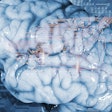AI is one of the inescapable buzzwords in today’s technology landscape. In healthcare, algorithms hold the promise of increasing efficiency and, potentially, diagnostic accuracy. Radiology is ground zero for many of these innovations, and increasingly radiologists are being asked to take the lead in helping the healthcare system make the most of these technological breakthroughs.
Radiologist as a technology leader is, in many ways, a very familiar role. Radiology led the charge in the adoption of digital technology and made the seemingly miraculous accessible. Remember, one of Superman’s core superpowers was x-ray vision! With AI, a whole new focus is needed to educate radiologists on the promise, potential, and even peril of this exciting new technology. This education is not only for the next generation; it will also be a crucial component of the continuous learning landscape. Morris Panner, President of Intelerad.
Morris Panner, President of Intelerad.
By investing in AI education, healthcare organizations can empower radiologists to streamline workflows, enhance diagnostic accuracy, and deliver personalized care. The future of medical imaging and patient care could be, in large part, contingent on the transformative potential of radiologists educated about AI.
Not for the faint of heart
In a profession where precision and timeliness are paramount, the integration of AI in radiology practices has the potential to significantly enhance productivity and patient outcomes. Yet advances in technology have not automatically translated into improvements in day-to-day operations. It is navigating this path – from amazing clinical promises to actual results – that challenges today's radiologists.
There is no doubt the technology is amazing. The examples are many. AI algorithms, powered by self-learning capabilities, can analyze medical images with precision, identifying patterns and potential anomalies that may be missed by the human eye. Additionally, AI facilitates image preprocessing, removing noise and artifacts from medical images, ensuring that radiologists work with high-quality images that enhance diagnostic accuracy.
In a study on medical image colorization, researchers used AI to add color to medical images while preserving important details, making it easier for doctors to understand and analyze them. Color can provide contrast, revealing valuable diagnostic information for treating patients, as well as for educational purposes. When tested on a dataset of medical images, the new method performed better than existing methods, with an average improvement of 8.48% in image quality.
Even more than diagnostic use cases, today we see AI drive improvements in workflow that make radiologists dramatically more efficient. AI-compatible medical imaging tools with prioritization features optimize imaging operations by identifying critical studies and automatically elevating them to the top of radiologists’ reading lists. This intelligent allocation of resources accelerates the diagnostic process and enables clinicians to focus on high-priority cases and deliver prompt, accurate results.
In addition to organizing worklists, AI continues to streamline radiology workflows by automating reporting and quality control processes. Generative AI applications can improve report creation by making it easier and faster for radiologists to dictate findings, which are immediately converted into detailed and precise reports. AI algorithms can also offer quality control, automatically checking image quality and flagging substandard images so time is not wasted reading them, thereby minimizing diagnostic errors. By augmenting radiologists' expertise with its analytical prowess, AI enables healthcare professionals to focus on more complex, high-value tasks.
AI education and training
To equip the next generation of radiologists with the skills necessary to effectively integrate AI into their practices, healthcare education programs must prioritize comprehensive training and upskilling initiatives. These programs should include a variety of instructional sessions that cover both the interpretative and non-interpretative applications of AI in clinical practice, ensuring new radiologists possess well-rounded, comprehensive knowledge of the technology's capabilities and limitations.
For example, when Lahey Hospital and Medical Center, a physician-led nonprofit teaching hospital at Tufts University School of Medicine, integrated six new AI algorithms into their clinical workflow, they encouraged all radiologists to familiarize themselves with AI. To help, Lahey radiology department chair Christoph Wald, MD, relied on the American College of Radiology’s Data Science Institute, which developed a web-based catalog called AI Central that radiologists can use to learn more about AI algorithms that have U.S. Food and Drug Administration (FDA) approval. Wald's team found it useful, and he encourages other practitioners who are interested in AI integration to utilize the resource to make informed decisions about which algorithms they might want to consider.
Other major professional societies are also focusing on high-quality continuing education, such as the RSNA and Society for Imaging Informatics in Medicine (SIIM). Recognizing the rapid evolution of AI, ongoing learning and adaptation are essential, requiring radiologists to stay abreast of the latest developments and continually expand their skill sets to remain effective and provide high-quality patient care.
Challenges and concerns
The usage of AI in radiology offers numerous benefits; it also presents challenges and concerns that must be addressed. The variability in imaging and diagnostic protocols, for example, is one such hurdle to the integration of AI in medical imaging practices, as it can impede the accuracy of AI-driven image analysis and abnormality detection.
Recognizing the issues caused by a lack of standardization, the Brookings Institution called for the FDA to regulate the market and encouraged policymakers and medical societies to consider strengthening regulatory guidance on AI algorithm performance standards and testing. The industry’s continuous echo of this call could amplify the message and increase the likelihood of meaningful change.
While it’s accepted that the accuracy of AI algorithms is partially dependent on the quality of training data and protocols used to teach them, the full decision-making processes of algorithms remain unclear. As a result, it’s difficult to comprehend what elements factor into their predictive accuracy. Despite those unknowns, it’s safe to say that AI is only as good as its training, so an industry-wide understanding of those practices is crucial. While FDA regulations and the EU AI Act bring standardization and reduced variability, protocols must be further clarified to ensure training practices – beyond just testing – are rigorous enough to guarantee reliable performance in clinical settings. Required transparency would facilitate consistency and accuracy in medical imaging analysis while building radiologists’ trust, which could foster proficiency and drive adoption of the technology, specifically for use in medical devices.
Those missing pieces may give AI a "black box" feel that can erode clinician trust, hinder interpretation of results, and slow the integration of AI into clinical decision-making workflows. It’s no wonder many radiologists are hesitant when it comes to AI adoption. A European Society of Radiology survey of practitioners in 229 institutions across 32 countries found that 40% of radiologists polled have experience using AI in their clinical practice, and of those who haven’t used it, only 13.3% are interested in implementing it. Of the remaining respondents, 52.6% said they have no interest in it, while 34.1% declined to answer.
We are in the early days of AI adoption and implementation, yet there is no doubt that these tools are going to become a part of our healthcare landscape. Radiologists, who traditionally are at the forefront of innovation, are likely to lead the way again as we embrace this new technology. Education at every level is needed to ensure that radiologists at all stages of their careers can contribute to this multifaceted debate, consume technology critically, and help other caregivers and the public at large appreciate what could usher in a revolution in care and access.
Morris Panner is president of Intelerad, an enterprise imaging and software developer.
The comments and observations expressed do not necessarily reflect the opinions of AuntMinnie.com or AuntMinnieEurope.com, nor should they be construed as an endorsement or admonishment of any particular vendor, analyst, industry consultant, or consulting group.



















